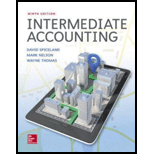
Transaction analysis
• LO2–1
The following transactions occurred during March 2018 for the Wainwright Corporation. The company owns and operates a wholesale warehouse.
1. Issued 30,000 shares of common stock in exchange for $300,000 in cash.
2. Purchased equipment at a cost of $40,000. $10,000 cash was paid and a note payable was signed for the balance owed.
3. Purchased inventory on account at a cost of $90,000. The company uses the perpetual inventory system.
4. Credit sales for the month totaled $120,000. The cost of the goods sold was $70,000.
5. Paid $5,000 in rent on the warehouse building for the month of March.
6. Paid $6,000 to an insurance company for fire and liability insurance for a one-year period beginning April 1, 2018.
7. Paid $70,000 on account for the merchandise purchased in 3.
8. Collected $55,000 from customers on account.
9. Recorded depreciation expense of $1,000 for the month on the equipment.
Required:
Analyze each transaction and show the effect of each on the
Example:
1. Assets + 300,000(cash) = Liabilities + Paid-In Capital +
Trending nowThis is a popular solution!

Chapter 2 Solutions
Intermediate Accounting
 Financial Accounting: The Impact on Decision Make...AccountingISBN:9781305654174Author:Gary A. Porter, Curtis L. NortonPublisher:Cengage Learning
Financial Accounting: The Impact on Decision Make...AccountingISBN:9781305654174Author:Gary A. Porter, Curtis L. NortonPublisher:Cengage Learning
